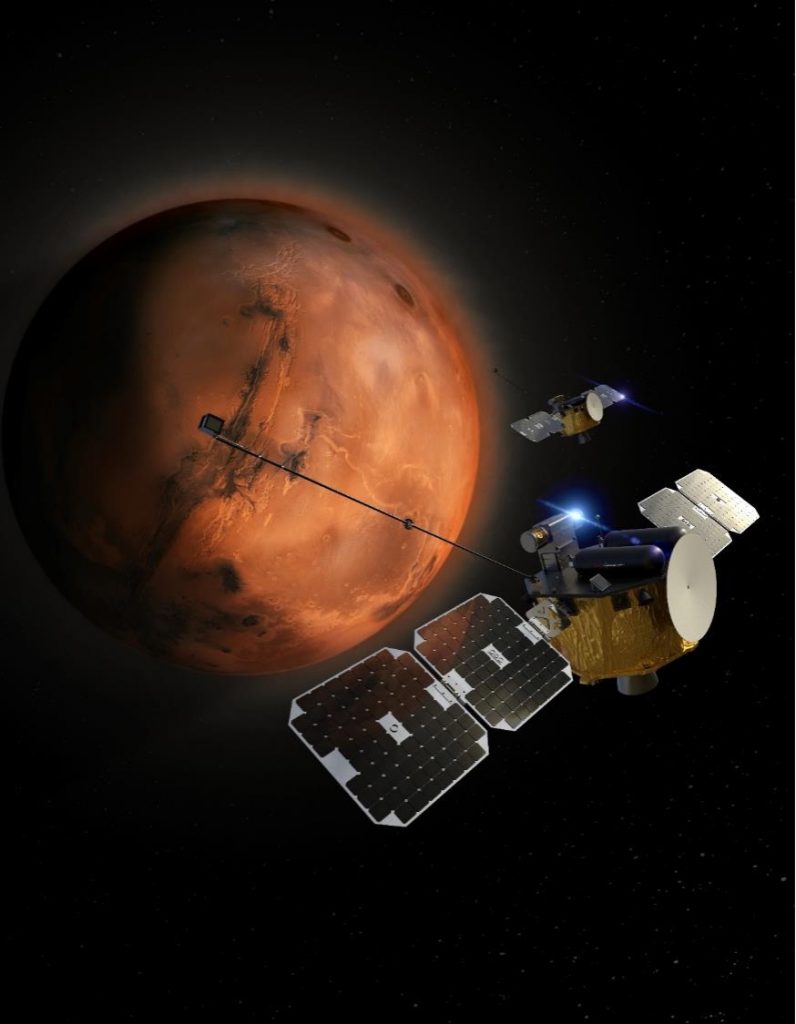
NASA’s Escape and Plasma Acceleration and Dynamics Explorers, or ESCAPADE mission, passed a mission review on August 17, 2021, moving the mission into its next phase with a new target launch readiness date of October 2024.
The review, Key Decision Point C, evaluated the mission’s preliminary design and project plan to achieve launch by its target launch readiness date. With the successful review, ESCAPADE now moves into phase C, which includes the final design of the mission and building of the instruments.
“We are thrilled to pass this critical milestone, the culmination of two years of science and engineering work from a talented and dedicated team at UC Berkeley and our partners,” said Rob Lillis, space physicist at UC Berkeley and principal investigator for ESCAPADE. “We’re very excited to now move towards final designs, assembly, test, launch and get on our way to Mars.”
ESCAPADE consists of two identical interplanetary Photon spacecraft developed by Rocket Lab. Both spacecraft are about the size of a mini-fridge and weigh no more than about 250 pounds (120 kilograms) excluding fuel.
“This is a hugely promising mission that will deliver big science in a small package,” said Peter Beck, Rocket Lab founder and CEO. “Our Photon spacecraft for ESCAPADE will demonstrate a more cost-effective approach to planetary exploration that will increase the science community’s access to our solar system for the better. I’m thrilled that the hard work and dedication of the engineering teams at UC Berkeley and Rocket Lab to date have paid off and the mission has been approved by NASA to begin final design and building.”
Launching no earlier than January 2024, the twin ESCAPADE spacecraft will spend 11 months in interplanetary space before entering a highly elliptical orbit around Mars. They will spend six months gradually descending into the same nominal science orbit like pearls on a string, passing within 100 miles (160 kilometers) of the Martian surface at closest approach.
“For ESCAPADE, we’re evaluating a number of rideshare options to enable this critically important science while also lowering costs,” said Alan Zide, program executive for the mission at NASA HQ.
ESCAPADE will study how Mars’ magnetosphere – the magnetized area of space around the planet – interacts with the solar wind, and the processes driving its atmospheric escape.
“This constellation of two satellites at Mars will answer big questions about the atmosphere and the solar wind in real time,” said Shannon Curry, project scientist for the mission at UC Berkeley.
“With simultaneous two-point observations, ESCAPADE will bring us the first ‘stereo’ picture of this highly dynamic environment,” Lillis added.
Using instruments to measure magnetic fields, ions, and electrons, the ESCAPADE spacecraft will analyze how Mars’ magnetic field guides particle flows around the planet; how energy and momentum are transported from the solar wind through Mars’ magnetosphere; and what processes control the flow of energy and matter into and out of the atmosphere.
“Our heliophysics decadal surveys” – the community-wide survey used to set NASA’s scientific objectives – “have identified the scientific need to study the space environments of other planets,” said Jared Leisner, ESCAPADE program scientist at NASA HQ. “By studying the same processes at different planets, we gain key insights into how they function both at Earth and at other planets beyond the solar system.”
ESCAPADE is led by the University of California, Berkeley. The mission is managed by the Planetary Mission Program Office at NASA’s Marshall Space Flight Center. ESCAPADE is part of the NASA Small Innovative Missions for Planetary Exploration (SIMPLEx) program and is funded through the Heliophysics Division at NASA HQ.
By Miles Hatfield
NASA’s Goddard Space Flight Center, Greenbelt, Md.
